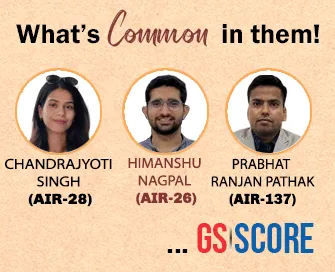

16th September 2023 (9 Topics)
Editorials
Context:
The invitation for the G-20 summit in New Delhi, calling the Indian President 'President of Bharat,' sparked controversy due to political tensions and distrust across the nation.
Constitutional Perspective on Changing India's Name
- Constitutional Clarity: The controversy surrounds the use of 'President of Bharat' in official G-20 summit invitations under India's presidency, raising constitutional questions.
- Constitutional Amendment required: Constitutionally, the official title is 'President of India,' specified in Article 52, and can only be changed through a constitutional amendment (Article 368).
- A Name game: The Constitution does mention "India, that is Bharat" in Article 1, but this clarifies that 'Bharat' serves as a translation for 'India' rather than an interchangeable term.
Implications of Using 'Bharat' Interchangeably
- Potential Confusion: Using 'Bharat' interchangeably with 'India' in official communication could create confusion, especially in international agreements and treaties.
- Can hamper global image: The official name, 'Republic of India,' is consistently used in international affairs and should not be altered arbitrarily.
- Bharat as a secondary suggestion: The Constituent Assembly originally debated using 'India' as the sole name and added 'Bharat' later as a compromise, with no intention of interchangeability.
Broader Implications and Impacts
- Controversy and Alienation: Changing a country's name should not be a political party's agenda; consensus is essential in diverse countries like India.
- To break Colonial legacy: A rushed effort to distance from colonialism by altering names risks alienating certain sections of the population.
- Hinder Unity and Cooperation: India's newfound anti-colonial enthusiasm should align with its motto of 'VasudhaivaKutumbakam,' promoting global unity rather than division.


Editorials
Context:
There have been several allegations of the anti-state actors' financial activities in Northeastern region of India and their impact on regional dynamics, highlighting the need for cooperation between India and Bangladesh to address these issues.
The Nature of Anti-State Actors
- Varied Beginnings: Anti-state actors, often involved in armed conflicts, employ distinct strategies to gain support and recognition, initially emphasizing theoretical foundations.
- Initial Revolutionary Objectives: These groups, especially in the Indian subcontinent, tend to adopt revolutionary objectives, sometimes resonating with the public.
- Erosion of Revolutionary Character and Leadership Transition: However, the revolutionary character often erodes as they consolidate power, with leaders transitioning into warlords, challenging national governments and influencing regional dynamics.
The Case of ULFA
- Ideological shift:The United Liberation Front of Asom (ULFA) leader exemplifies the shift from revolutionary to warlord, with ties to external entities like ISI and Chinese intelligence.
- Concern associated: The control over ULFA's leader in finances and alleged connections with Chinese ordnance factories and Bangladeshi business conglomerates raise concerns.
- Unwanted dispute: Investigations into ULFA leaders’ properties in Bangladesh and their financial activities highlight potential influence in the region, impacting India-Bangladesh relations.
Broader Implications
- Call for Investigation: Allegations of terror actors from Bangladesh investing in Indian stock markets and real estate, along with ULFA's business ties in Bangladesh, require thorough investigation.
- Necessity of India-Bangladesh Cooperation: The evolving landscape of Islamist terror in South Asia necessitates cooperation between India and Bangladesh in addressing these concerns.
- Resolution for Sustaining Anti-Terror Alliance: Maintaining a lasting alliance against terror demands transparency and resolution of these issues, even if it involves temporary embarrassment.


Editorials
Context:
To achieve global food security and 'Zero Hunger' by 2030, adopting science-based technologies like GM crops is crucial amid climate change challenges.
Need for Genetic Improvement in Crop Production
- Boosting Food Production: To achieve food and nutritional security in the face of climate change, there is an urgent need to accelerate genetic improvement in crops.
- Superior crop varieties and hybrids: They are essential for higher yields, adaptability across diverse environments, and reduced resource inputs.
- The Green Revolution of the 1960s-70s; significantly increased food production, but new biotech/GM crops are required for climate resilience and nutrient-rich food production.
Economic Benefits of GM Crops
- GM Crop Adoption: Genetic modification of crops has been embraced worldwide, with 72 countries adopting GM crops for food, feed, and commercial cultivation.
- Benefits: GM crops have benefited over 1.95 billion people, mainly in Argentina, Brazil, Canada, India, and the United States.
- Helping developing countries: Economic gains from GM crops have exceeded 224.9 billion dollars, with the majority of beneficiaries being farmers in developing countries.
GM Mustard as a Solution for Edible Oil Deficit in India
- Focus on Mustard Agriculture: India faces a significant edible oil deficit, relying on imports for 60% of its demand.
- Increasing Productivity: Mustard, a vital oilseed crop, has low yields compared to global averages, necessitating productivity improvements.
- Help to increase farmer’s Income: Genetic engineering efforts, like the GM mustard hybrid DMH-11, aim to enhance domestic edible oil production and farmer incomes.


Editorials
Context:
India is technologically and economically far behind China, but it can show off its capabilities in one domain: space.
ISRO's Changing Perceptions and Achievements
- ISRO's Remarkable Journey: ISRO, the Indian Space Research Organisation, is undergoing a rebranding phase, propelled by its recent successes including lunar missions and a Mars orbiter.
- Advancing on the Global Stage: The organization is gearing up for a solar probe and a manned mission, reflecting India's evolving role in the global arena.
- The Lingering Irony: Despite these achievements, a long-standing irony remains – India, a spacefaring nation, grapples with challenges like food security, education, and poverty at home.
Evolution of India's Space Program
- From Jugaad to Scientific Excellence: India's early space endeavors were often associated with frugality and jugaad (resourcefulness), epitomized by missions like Mangalyaan, which garnered global attention for its cost-effectiveness.
- Cost effective efforts: However, ISRO's success also involves scientific innovation, such as utilizing angular momentum to reduce fuel usage and the country's cost-effective inputs.
- Become a global example: India's space objectives differ from technologically advanced nations, focusing on development, earth sciences, and national integration rather than space tourism or planetary colonization.
Geopolitical Significance of India's Space Program
- ISRO's Geopolitical Role: ISRO's space program serves as a geopolitical signal, showcasing India's capabilities in the global arena, particularly concerning China's maritime ambitions.
- India's Lunar Mission: India's lunar mission, aimed at putting an Indian on the moon, reflects its determination to assert influence and competence.
- Compelling Message to the World: Despite the ongoing irony of domestic challenges, India's lunar mission sends a compelling message to the world about its capabilities and aspirations.



